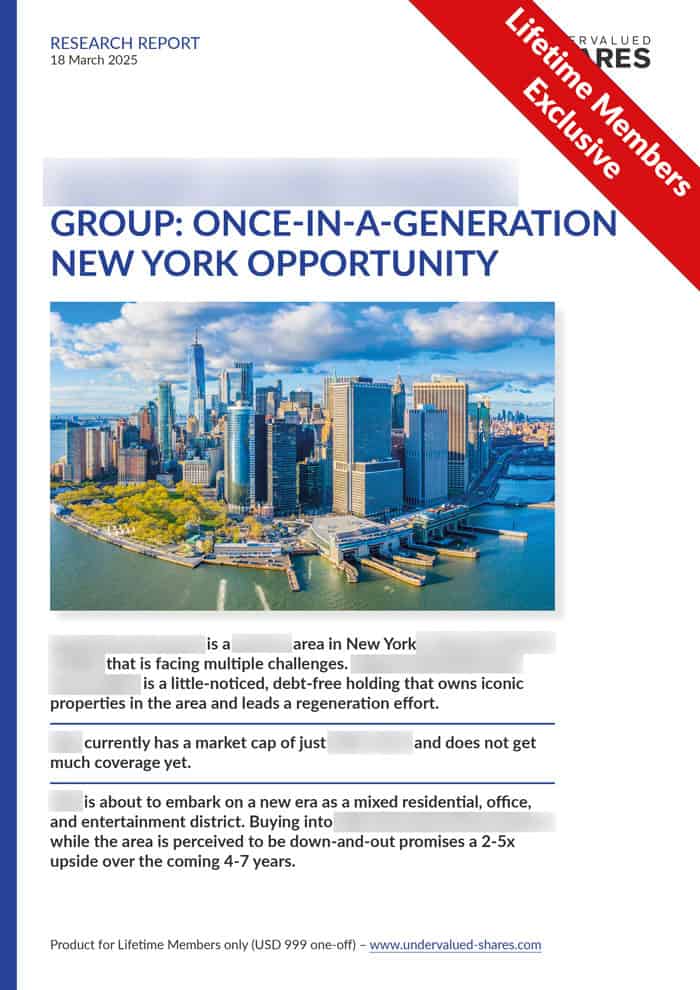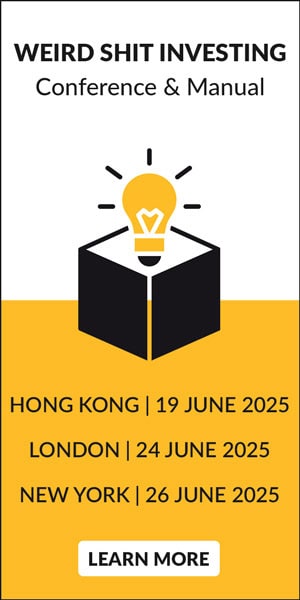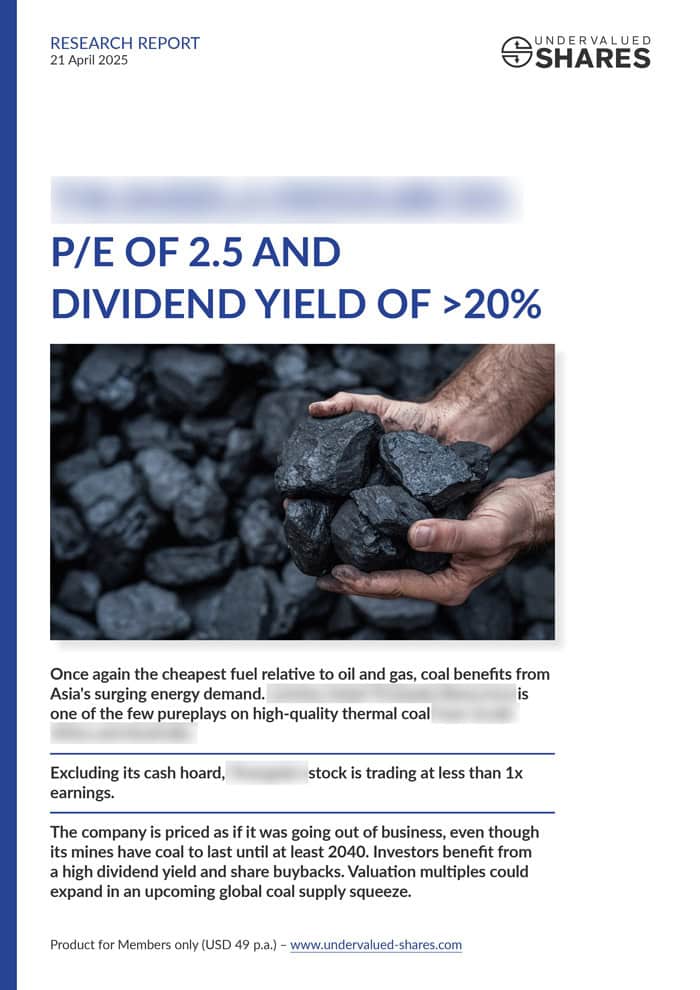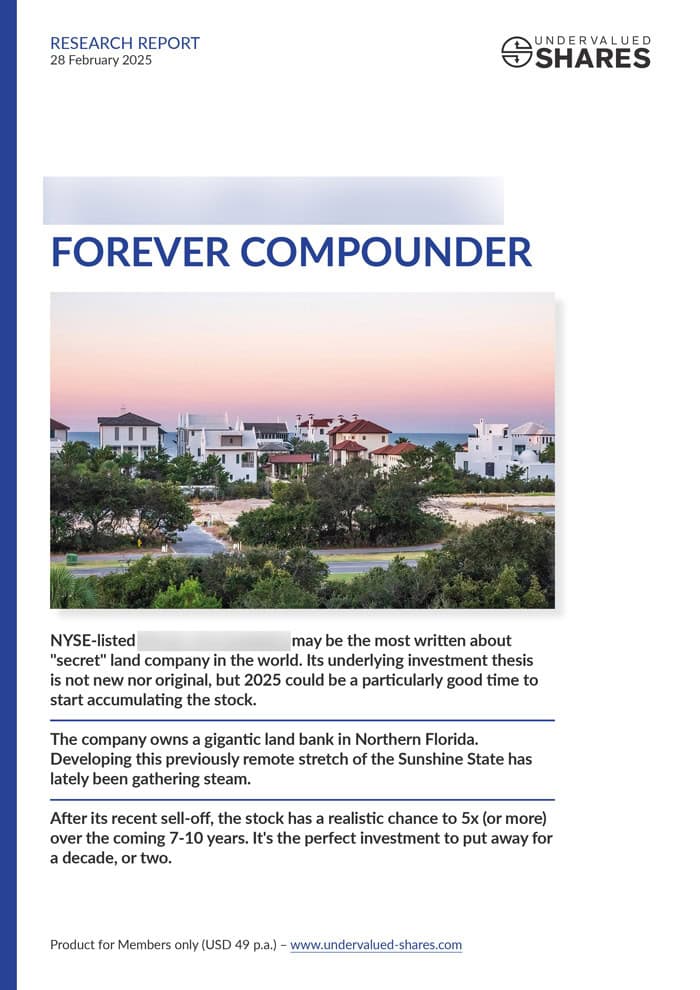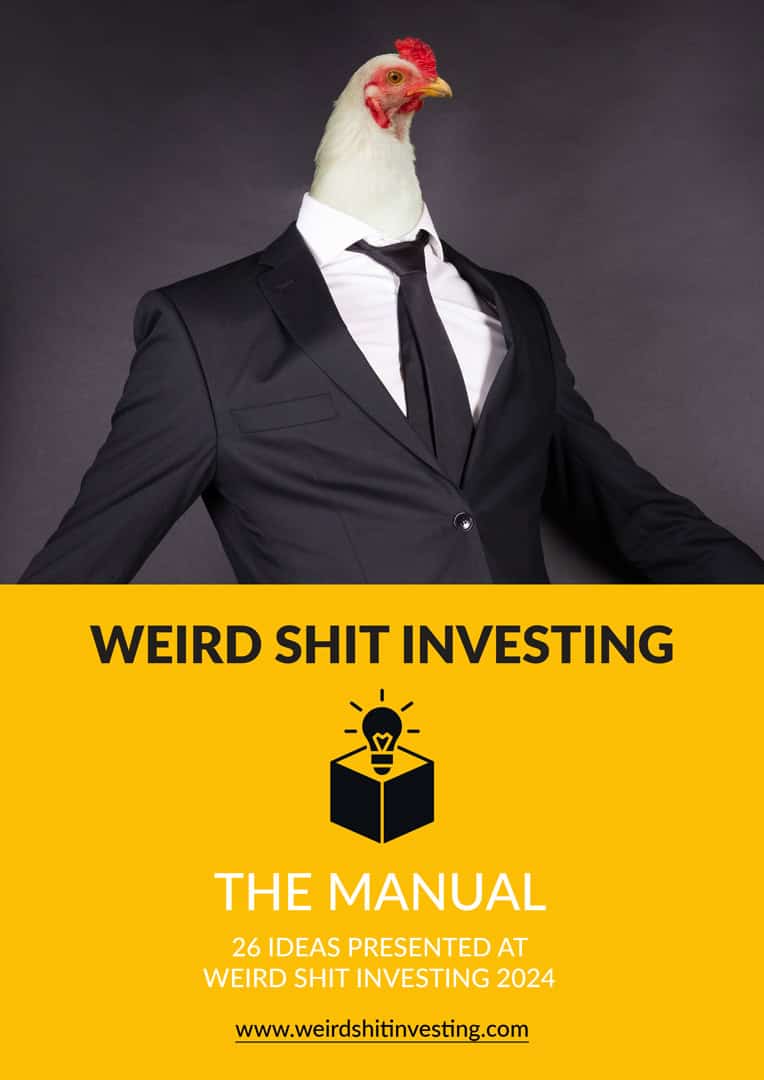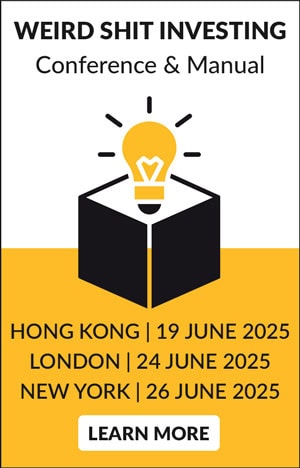There is a small – but growing – market for high-end, tailor-made equity research.
Its users don't mind paying USD 5,000 or even USD 50,000 a year to get access to exclusive information, in-depth data, and genuinely original investment ideas.
The analysts aren't ordinary newsletter authors, but hard-hitting financial analysts and sector specialists who decided to set out on their own.
Undervalued-Shares.com shines a light on this industry of high-priced, independent research services.
The decline of equity research – or so they said!
Equity research has gone through some dramatic changes.
The most notable development was the European Union's 2018 Markets in Financial Instruments Directive II ("MiFID II"), which required the "unbundling" of research services.
Until then, equity research issued by investment banks and brokerage firms didn't have an explicit price tag. Instead, if you chose to trade or otherwise do business with these firms, the research came for free as part of their overall services. To use the industry lingo, your subscription to these research reports was "bundled" with the trading commissions or corporate advisory fees.
The EU's directive forced the unbundling of research from other services, which happened on the back of a number of long-known conflicts of interests and scandals. E.g., investment banks nudged their equity analysts to recommend stocks as a way of winning business for IPOs or capital raises. Since 2018, the EU has required money managers to pay for trading and research separately.
According to Vali Analytics, the number of equity analysts employed by the world's 15 largest banks has fallen to about 3,000, from 4,600 a decade ago. Most of these cuts happened in Europe, suggesting that MiFID II was the primary reason for the decline in equity research. According to Substantive Research, spending on research has sunk 50% since 2018, with Europe hit hardest, followed by Asia.
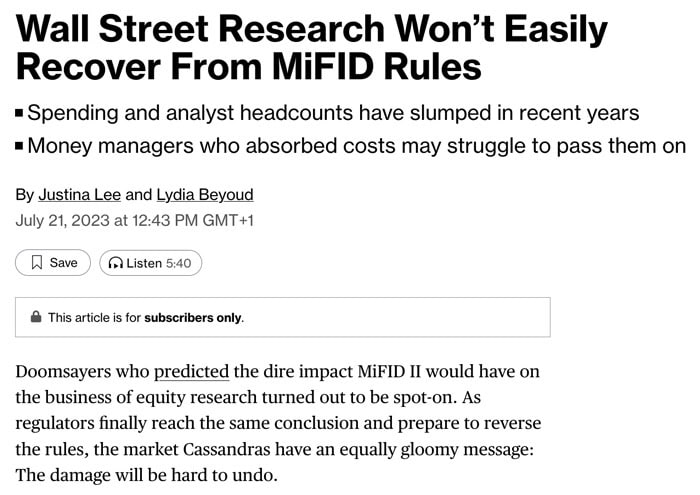
Source: Bloomberg, 21 July 2023.
One issue that the MiFID II regulation struggled with is the long-standing reluctance of investors to pay separately for research. Whether rationally or not, there is a widespread unwillingness to cough up cash for research, probably influenced by factors such as:
- The difficulty of putting a monetary value on research. A single research report may generate millions of profits in markets, but it's impossible to figure out in advance which report will achieve that.
- The fact that everyone is nowadays drowning in (mostly free) information.
- The relative ease with which digital copies of research reports can be passed on, even though it violates copyright laws.
Besides, is the equity research provided by large investment banks and brokerage firms actually of any value? Critics have long pointed out that trying to outguess other people in the quarterly numbers game is not "investment research" but a "commoditised service". This was argued even before the rise of AI, and it may be even more true now.
The US had also looked at the unbundling of research, but in the end decided not to go down that route. In the early 2000s, the then New York attorney general, Eliot Spitzer, noted how equity research was, in reality, a marketing front for advisory and underwriting functions. His proposal for investment banks to spin off their research units was abandoned due to a sense that these independent units would not be able to operate economically. In 2007, the U.S. Securities and Exchange Commission also floated the idea of unbundling, but it yet again failed to gain traction.
In the meantime, the EU's bureaucrats have learned a lesson that their idealistic views struggle to hold up to reality. A memorandum issued by the European Commission in 2022 admitted that the MiFID II rules "might have impaired the overall availability of research" (note the word might!). Rather than creating new market conditions, the regulation led to capacity leaving the market – who could have possibly seen this coming? The EU fairly quickly walked back on some of the regulation for small-cap research, which had gotten hit the hardest by MiFID II. It is now looking to reverse the ban on bundled research. The UK, no longer tied to EU regulation due to Brexit, already went about cancelling this regulation in 2024.
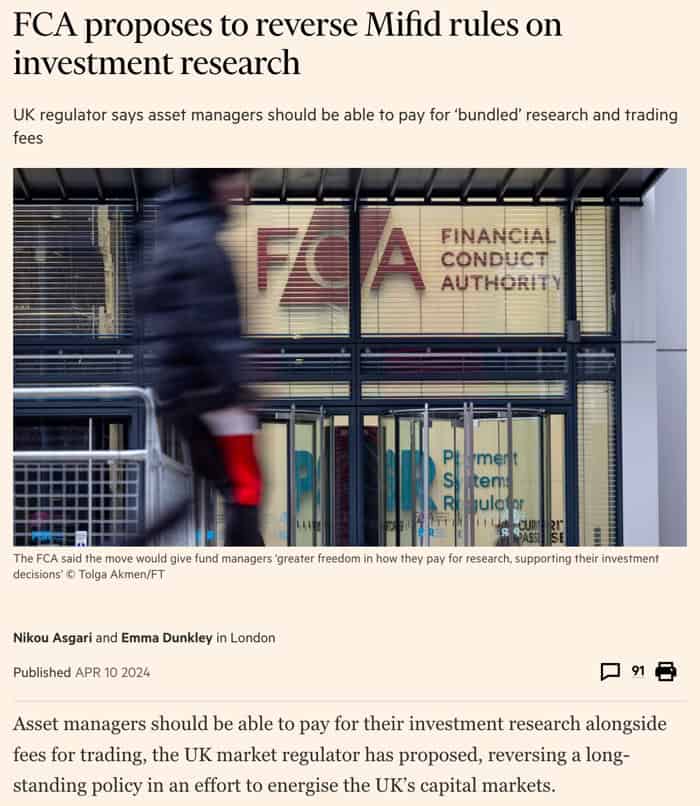
Source: Financial Times, 10 April 2024.
The problem is that a business, once destroyed, cannot be resurrected by public edict. That is, of course, unless the EU introduces government-funded equity research. Would anyone put it past them? The UK has already seen at least one instance of someone actually proposing the government puts funding into equity research. Yet again, what could possibly go wrong?
In any case, it's unlikely that a change of rules will make matters revert to how they were before the EU came crushing down on businesses. The people who used to be in the industry have moved on to other jobs. Besides, the world as a whole has moved on.
None of which is to say that equity research couldn't have a unique – and significant – value. If done well, it can make the difference between beating the markets and lagging the markets. It can help investors – whether fund managers, family offices, or private investors – find those one or two gems a year that they need in order to outperform.
As Undervalued-Shares.com found during its digging into the industry, it may just be that market forces will support the growth of a new model of independent research.
There has been little reporting about it so far, but we may now see the ongoing growth of high-end, bespoke research services.
New players entering the industry
One factor that Undervalued-Shares.com is proud of is that its own success (financially and otherwise) has already inspired a handful of other people to set up their own business in equity research.
This includes Maiden Financial, a new equity research service offered by Gwen Hofmeyr. Formerly an equity analyst at a family office in Vancouver, Hofmeyr has set up her own research outfit to provide "long-form research reports on under-analyzed and out-of-favor companies and industries, and building comprehensive datasets on covered companies". This happened after Undervalued-Shares.com published her outstanding work on Hingham Institution for Savings and Ingles Markets, and connected her to The Bear Cave's Edwin Dorsey for an interview in his Sunday's Idea Brunch. The interview with Dorsey had droves of portfolio managers and investors got in touch with Hofmeyr, which catalysed her decision to set out on her own.
Like all the other services featured in today's Weekly Dispatch, Hofmeyr's service is not for everyone, but for a selective few.
The standard package for 5-6 long-form reports per year is USD 3,599. The elite package costing USD 5,699 includes extras such as roundtables, executive interviews, and quarterly company updates.
At a time when everyone is obsessed with clickbait and AI, Hofmeyr believes that the edge exists in going back to basics and applying human intelligence. She likes to describe her work as "financial archaeology".
Some will say that her work goes too deep, and others love her just for that. Adam Mead, the CEO of Mead Capital Management, was happy to be publicly quoted as saying "Gwen's research is of the highest quality. I've learned a lot from her and I'm pleased to recommend her work."
Hofmeyr has proven wrong the long-standing criticism that it's difficult to charge a sufficient price and find clients. Her goal for the first year of operation had been to find an initial 25 clients; according to her client brochure she has already found 20 within the first five months. The majority of her clients are portfolio managers of funds with USD 20-250m of assets under management, while another large percentage of her clients are C-suite executives. For them, having an outsourced brain like Hofmeyr is a lot more economic than trying to find, hire, and supervise an analyst of their own.
Is this the age of the fractional equity analyst?
This approach would make some sense. Hiring a decent analyst in the US nowadays sets you back USD 200-300k per year. Alternatively, you could subscribe to 10-20 high-end research services where the author provides a degree of personal access.
Undervalued-Shares.com discovered an entire sector of such service providers. However, even though there are frequently published lists of investment-related Substacks and free Twitter accounts (such as this list published by Edwin Dorsey and this list from Clark Square Capital), no one seems to have made a concerted effort to pull together an overview.
Another example that fits into this niche is Betaville published by Ben Harrington. A word play on the Financial Time's Alphaville column, Harrington is focused on information about M&A deals, such as takeover bids and mergers. Betaville clients get three levels of alerts about potential deals, ranging from "uncooked" (mere market gossip) to "well done" (market gossip that has been checked with Betaville's top sources). According to Harrington, Betaville is not actually classified as "research" as it doesn't provide research or investment advice. Instead, it's a news and data provider, so it falls into the "market data" bracket.
Priced at GBP 20,000 (USD 26,000) per year, Betaville's price appears among the highest as one-man shops are concerned. The price tag is all the more remarkable when compared to the website's rather basic appearance. Harrington has been in the business for years, though, and must be doing well as he upped the price considerably sometime over the recent years.
One undoubtedly valuable service is Quo Vadis Capital. Its principal, John Zolidis, offers "an edge in financial markets" thanks to his "proprietary unit-level economic analysis, developed over more than two decades, to forecast earnings revisions and pick long and short ideas".
However, pricing is something Zolidis will only discuss directly with prospective clients. No doubt, it's more expensive than your average Substack, thanks to Zolidis' sharp analytical skills.
The opacity of this entire sector certainly adds to its allure and may also express why it offers value. After all, to get an edge, you need to do something that's different from what everyone else is doing. Among this type of research services, you'll find analysts who *truly* deserve being called independent thinkers. Not tethered to large corporations means they can more freely speak their mind.
It all comes with the problem, though, how to find such research providers and separate the wheat from the chaff?
As it were, there is a website to help you with this challenge.
Introducing: Independent Research Forum
Independent Research Forum (IRF) was set up in 2016 with the aim of connecting funds, family offices, and wealth managers with providers of high-quality, independent research and alternative datasets.
For independent research providers, IRF acts as a sales funnel to find clients. Research providers only have to pay IRF if they find clients, i.e. it's purely revenue-based. For smaller research providers and the countless one-man shops of the industry, this is one way to avoid having to build up their own sales team. Instead, they benefit from the large rolodex of potential clients that IRF has identified over the years, and which they engage through events, publications, and one-to-one relationships. In effect, IRF is a match-making service.
For portfolio managers, it offers both a filter and an overview of what's available out there and how to find best-in-class research.
The IRF database nowadays contains 300 providers of research, over 230 of which offer research on specific equities. Others are macro-based, and some have an overlap of macro and specific equities. Typically, they charge a five-digit sum per year although there are also some lower-priced providers.
A quick look through the IRF's weekly, publicly available newsletter The Cut revealed firms such as the following:
- 2Xideas, a Switzerland-based service that tries to identify mid-cap stocks with a 2x potential over 5-7 years.
- Forensic Alpha, a service that uses machine intelligence to help portfolio managers spot critical red flags hidden within financial statements and governance disclosures.
- 86Research, which has mainland China analysts covering globally listed mainland China companies, with a focus on the Internet, media, gaming, travel, EV and consumer. In addition, the company provides pre-IPO analysis, China-based conferences, and ancillary services.
- Aequitas Research, which covers IPOs and placements across the Asia Pacific using a fundamental bottom-up view combined with a proprietary quantitative framework. Markets includes Hong Kong, China ADRs, India, ASEAN, Korea, Japan, and Australia.
- Costigan Reports, a Canadian provider of equity research which focuses on actionable long and short equity investment ideas across North American equities.
- Games Investor Consulting, a tailored research service for the games industry.
- Rimor Equity Research, a provider of sell-side equity research for the Australian market.
- Spin-Off Research, which focuses its investment research on information-poor, inefficiently-priced spin-off situations. It was founded in 1997 and is priced at USD 30,0000 per year.
Registering for IRF is easy; a free registration allows you to check short profiles on all the research providers that have decided to join the IRF platform. Users can also build a stock portfolio on the platform so as to get alerts when one of the reseach providers publishes something about a specific name.
For research providers, IRF offers introductory conversations about collaborating, which can also include introductions to alpha capture funds where the research provider gets a share of the investment performance.
In total, IRF's 15 staff claim relationships with 1,000 asset management houses. IRF's founder, Edward Blad, has over 25,000 LinkedIn connections – a unique rolodex built up over two decades.
IRF is a veritable source of curated, high-quality independent research. The web clearly needs one such consolidated platform, which saves everyone a lot of time.
What else is out there?
Recommendations and endorsements received from the Undervalued-Shares.com network include the following:
- Speedwell Research, a provider of comprehensive research on public companies to equip investors with a thorough understanding of the business. The company's equity research reports usually range anywhere from 50-170 pages in length (with an average length of 80 pages), and reportedly cost USD 5,000 per year.
- Off Wall Street, an independent research firm that since 1990 has helped "professional investors outperform by seeing things differently". Delivering short ideas, in particular, its average short has generated 10% annual alpha vs S&P 500 Index short since 2003. One fund manager, who has been a satisfied client for nearly two decades, uses Off Wall Street to double-check LONG ideas.
- Arete Research, an equity research specialist for the industries of semiconductors, enterprise software and cyber security, Internet and e-commerce, telco, cable and media. According to the US-based firm, it counts 250 of the world's most sophisticated tech investors as clients.
- MoffettNathanson, who similarly to Arete Research provides independent equity research for the technology, media and telecoms landscape (e.g., Internet and e-commerce, telecommunications, digital and telecoms infrastructure, online sports gambling, and video games). Highly acclaimed with industry awards, subscribing to its services reportedly costs USD 50,000 per year. (Isn't Undervalued-Shares.com a snip at USD 49 per year? Sign up for an Annual Membership now if you haven't already to support great free articles such as this one!)
There are also a few providers that sit at the cross-section of newsletter publishing and independent investment research. One example worth highlighting is Valorem Research, a service that reports about special situations investing in the litigation finance space. Its author is an (anonymous) former patent litigator and M&A attorney from New York, who aims to write about four high conviction situations every year, with regular updates. Even though the annual subscription "only" costs USD 500, subscribers can also obtain a USD 5,000 per year Founder Member status that allows for deeper engagement with the author.
Last but certainly not least, there is Kuppy's Event Driven Monitor (KEDM), a service launched by Harris "Kuppy" Kupperman (a paying subscriber and friend of Undervalued-Shares.com). KEDM is a weekly compendium that keeps track of corporate events and catalysts, to help investors identify inflection points. Below is an overview of the events monitored by KEDM. At USD 4,000 per year (or USD 2,500 for Undervalued-Shares.com readers using coupon code Undervaluedshares-1500off) and given the team behind it, this is another high-end research service – even if it's more macro in its general weekly reporting and aims to have its readers decide where to focus their own equity research work using the reams of tables provided by the publication each week.
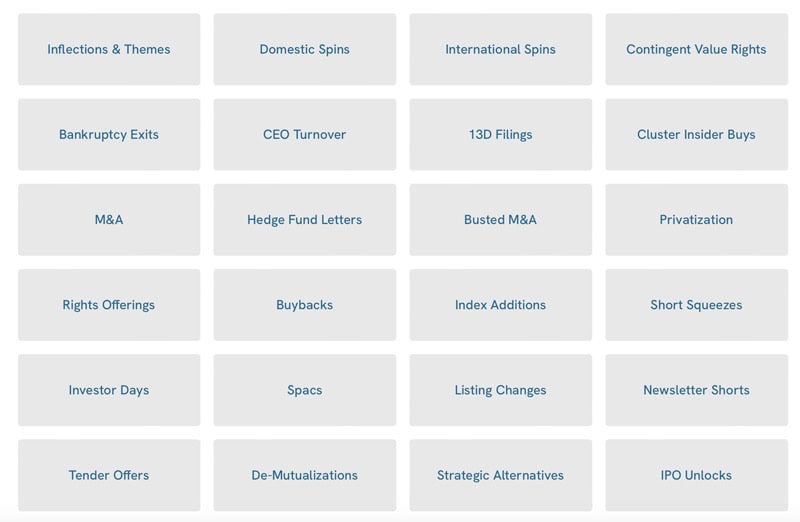
The type of situations monitored by KEDM.
What makes all of these research providers potentially uniquely valuable (and at this particular moment in time!) is the fact that markets have changed.
A growing opportunity set – and a growing market?
Alongside EU regulation, the rise of both passive investing and private equity has led to fewer analysts covering publicly listed companies.
Besides, many younger people and those with the right analytical mind prefer to work in fintech, crypto and similar sectors – where they tend to find a more collaborative, forward-thinking mindset than in traditional fund management.
As Barron's recently put it, these trends have led to a "brain drain" from equity research.
However, what this has also undoubtedly led to are growing inefficiencies in the public equity market.
Fewer eyeballs are watching companies (even large ones), which results in divergent pricing in the stock market.
The negative view is to say that this spiral has led to low valuations, and in turn to less interest – and it's now a doom loom for public markets.
The positive view is to say that there is now a bigger opportunity than at any time since 2009 – and you can generate alpha by being a good analyst and stock picker.
Indeed, as Barron's reported recently: "The average number of sell-side analysts covering an S&P 500 stock has fallen by 15% from a peak at the start of 1990, according to BofA. BofA tracks the analyst coverage of stocks in the S&P 500 and found that stock-picking strategies worked better on a universe of companies that have fewer analysts following them."
Small-caps can be particularly attractive because many are undercovered – and underloved by traders.
Gwen Hofmeyr may have just provided a visible example of the opportunity set that now presents itself to enterprising analysts, and to investors. There is a dearth of research that goes beyond looking at quarterly numbers, but there is also a growing number of High-Net-Worth-Investors, family offices and niche fund managers who are willing to pay good money for such services. In fact, self-direct HNWIs and family offices may well be the #1 target group for such research providers, at least as far as growth is concerned.
Cookie-cutter research written by junior staff members of investment banks is no longer valued by the market.
AI also hasn't reached the necessary level of lateral thinking yet. As Aaron Pek, a Malaysia-based value investor and Substack author recently put it in a LinkedIn post: "I can confidently say for now that AI in its current state is nowhere near 'prime time' for dislodging equity research analysts … In its current largely chat-based framework, AI simply pales at what someone with >5 years of industry experience can achieve, measured in terms of time spent to complete tasks."
For now, at least, nothing replaces having a decade (or two, or three) of research in originating and analysing investment ideas. To some extent, this also shows in the growth of the broad array of investment-related Subtacks available today. Substack is, without a doubt, a veritable marketplace of valuable investment ideas.
However, it also shows in the growth of highly-priced, independent equity and macro research.
For someone looking to scale only a select few investment theses into a high conviction trade with good risk/reward, getting hundreds of PDFs dumped on their desk each year may not be the right solution. They could be looking towards the independent thinkers and crazy outliers – the "mad scientist" types of the equity research industry.
Indeed, anyone looking to become the next Bill Ackman is probably better off looking off-the-beaten-path and digging deep.
High-end, tailor-made equity research may be small beer in the overall context of the research industry. However, some investors will conclude that it provides the most bang for the buck.
Out now: Iconic New York at a discount
Once every decade (or two), the world's iconic cities offer you an outstanding investment opportunity in real estate.
You can currently buy into one such opportunity in New York. It comes at a discount, ahead of prices probably catching up with much more expensive neighbourhoods of the Big Apple.
The latest report for Undervalued Shares Lifetime Members investigates one US-listed company that is exploiting this opportunity.
Its stock is a bargain with 2-5x upside over the coming 4-7 years.
Out now: Iconic New York at a discount
Once every decade (or two), the world's iconic cities offer you an outstanding investment opportunity in real estate.
You can currently buy into one such opportunity in New York. It comes at a discount, ahead of prices probably catching up with much more expensive neighbourhoods of the Big Apple.
The latest report for Undervalued Shares Lifetime Members investigates one US-listed company that is exploiting this opportunity.
Its stock is a bargain with 2-5x upside over the coming 4-7 years.
Did you find this article useful and enjoyable? If you want to read my next articles right when they come out, please sign up to my email list.
Share this post:

